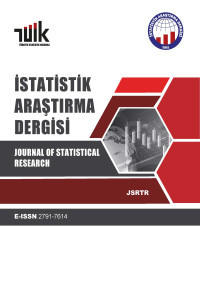Yaşam Çözümlemesinde Yarışan Riskler ve Bir Uygulama
Bu çalışmada, yaşam çözümlemesinde birden fazla başarısızlık sebebinin olduğu durum ele alınmıştır. Yarışan riskler kavramı, sebebe özel hazard fonksiyonu ve yaşam fonksiyonu gibi ilgili diğer fonksiyonlar incelenmiş ve yarışan riskler durumunda Cox regresyon modeline değinilmiştir. İş makinelerine ait lastik verileri ile bir uygulama yapılmıştır.
Anahtar Kelimeler:
Yarışan Riskler, Cox Regresyon, Yaşam Çözümlemesi
Competing Risks in the Survival Analysis and an Application
In this study, survival analysis is investigated when there are more than one distinct cause of death. The concept of competing risks, cause-specific hazard function and other related functions such as survival function is explained. In the presence of competing risks, the Cox regression model is examined. An application is carried out by using the tire data of big trucks.
Keywords:
Competing Risks, Cox Regression, Survival Analysis,
___
- CHAPMAN, J.W., FISH, E.B. and LİNK, M.A. (1999), Competing Risks Analyses for Recurrence from Primary Breast Cancer, British Journal of Cancer, 79, (9/10), 1508-1513.
- CHENG, S. C., FİNE, J.P. and WEI L.J. (1998), Prediction of Cumulative Incidence Function Under the Proportional Hazards Model, Biometrics, 54, 219-228.
- COX, D.R. (1972), Regression Models and Life Tables, Journal of Royal Statistical Society, Series B. 34, 187-202.
- COX, D.R. and OAKES, D. (1984), Analysis of Survival Data, Chapman and Hall.
- FINE, J.P. and GRAY, R.J. (1999), a Proportional Hazards Model For The Subdistribution of a Competing Risk, JASA, 94, 446, 496-509.
- FUSARO, R.E., BACCHETTI, P. and JEWELL, N.P. (1996), a Competing Risks Analysis of Presenting AIDS Diagnoses Trends, Biometrics, 52, 211-225.
- GOETGHEBEUR, E. and RYAN L. (1995), Analysis of Competing Risk Survival Data When Some Failure Types are Missing, Biometrika, 82, 4, 821-833.
- GREEN, S.B. and BYAR, D.P. (1980), the Choice of Treatment for Cancer Patients Based on Covariate Information: Application to Prostate Cancer, Bulletin Cancer, 67, 477-488.
- JOHNSON, R.E. and JOHNSON, N.L. (1980), Survival Models and Data Analysis, John Wiley and Sons.
- KALBFLEISCH, J.D. and PRENTICE, R.L. (1980), the Statistical Analysis of Failure Time Data, John Wiley and Sons.
- KAY, R. (1986), Treatment Effects in Competing-Risks Analysis of Prostate Cancer Data, Biometrics, 42, 203-211.
- KRONGRAD, A., LAI, H. and LAI, S. (1997), Competing Risks of Mortality in Prostate Cancer, Journal of Urology, 158, 865-868.
- KUK, A.Y.C. (1992), a Semiparametric Mixture Model For The Analysis of Competing Risks Data, Austral. J. Statist., 34, 2, 169-180.
- KUNDU, D. and BASU, S. (2000), Analysis of Incomplete Data in Presence of Competing Risks, Journal of Statistical Planning and Inference, 87, 221-239.
- LAWLESS, J.F. (1982), Statistical Models and Methods for Lifetime Data, John Wiley and Sons.
- LUNN, M. and MCNEIL, D. (1995), Applying Cox Regression to Competing Risks, Biometrics, 51, 524-532.
- MANN, N.R., SCHAFER, R.E. and SINGPURWALLA, N.D. (1974), Methods for Statistical Analysis of Reliability and Life Data, John Wiley and Sons.
- MARUBINI, E. and VOLSECCHI, M.G. (1994), Analysing Survival Data From Clinical Trials and Observational Studies, John Wiley and Sons.
- PRENTICE, R.L. and KALBFLEISCH, J.D. (1978), the Analysis of Failure Times in the Presence of Competing Risks, Biometrics, 34, 541-554.
- WOHLFAHRT, J., ANDERSEN, P.K. and MELBYE, M. (1999), Multivariate Competing Risks, Statistics in Medicine, 18, 1023-1030.
- ISSN: 1303-6319
- Başlangıç: 2002
- Yayıncı: TÜİK
Sayıdaki Diğer Makaleler
Damar Darlık Derecesi ve Risk Faktörlerinin Homojenite Analizi ile İncelenmesi
Eksik Blok Düzenlerinin Dual Yapıları
Alperen ÖZALP, A. Sermet ANAGÜN
Sürekli Değişken İçeren Grafiksel Modeller
Hülya BAYRAK, Fikri GÖKPINAR, Berrin ÖZKAYA
Yaşam Çözümlemesinde Yarışan Riskler ve Bir Uygulama
Durdu SERTKAYA, M. Tekin SÖZER
Bayes Ağlarda Koşullu Bağımsızlıkların İncelenmesi Üzerine Bir Çalışma
